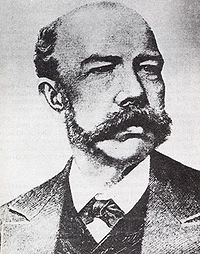
Manuel Saumell
Encyclopedia

A Life for the Tsar
A Life for the Tsar , as it is known in English, although its original name was Ivan Susanin is a "patriotic-heroic tragic opera" in four acts with an epilogue by Mikhail Glinka. The original Russian libretto, based on historical events, was written by Nestor Kukolnik, Georgy Fyodorovich Rozen,...
at about the same time.
Life
Saumell, from a destitute family, "destined to die young, after leading a miserable, peripatetic, sorrowful existence" was born in Havana. He studied pianoPiano
The piano is a musical instrument played by means of a keyboard. It is one of the most popular instruments in the world. Widely used in classical and jazz music for solo performances, ensemble use, chamber music and accompaniment, the piano is also very popular as an aid to composing and rehearsal...
with Juan Fédérico Edelmann, and harmony
Harmony
In music, harmony is the use of simultaneous pitches , or chords. The study of harmony involves chords and their construction and chord progressions and the principles of connection that govern them. Harmony is often said to refer to the "vertical" aspect of music, as distinguished from melodic...
, arranging, counterpoint
Counterpoint
In music, counterpoint is the relationship between two or more voices that are independent in contour and rhythm and are harmonically interdependent . It has been most commonly identified in classical music, developing strongly during the Renaissance and in much of the common practice period,...
and fugue
Fugue
In music, a fugue is a compositional technique in two or more voices, built on a subject that is introduced at the beginning in imitation and recurs frequently in the course of the composition....
with Mauricio Pyke, the director of an Italian opera
Italian opera
Italian opera is both the art of opera in Italy and opera in the Italian language. Opera was born in Italy around the year 1600 and Italian opera has continued to play a dominant role in the history of the form until the present day. Many famous operas in Italian were written by foreign composers,...
company which visited Havana. Saumell played the organ in church and interpreted Beethoven for trios, organized musical meetings, made orchestration
Orchestration
Orchestration is the study or practice of writing music for an orchestra or of adapting for orchestra music composed for another medium...
s and arrangements, and taught classes. "Saumell was a truly hard worker, sensitive, generous with others, demanding of himself; he was eager to achieve great things [and] inspired to great projects."
At 21 he fell heavily in love with a singer, Dolores de Saint-Maxent, who had introduced Schubert's work to Cuba. Unfortunately for him, she came from a wealthy family who would not countenance their marriage. All the same, for a time she permitted his attentions to continue. Saumell planned a nationalistic opera to show off her talent, based on the novel Antonelli by José Antonio Echevarría. The action takes place in Havana in 1590. A workforce of black slaves sets up the machinery of one of El Cerro
El Cerro
El Cerro is a village and municipality in the province of Salamanca, western Spain, part of the autonomous community of Castile-Leon. It is located 89 kilometres from the provincial capital city of Salamanca and has a population of 529 people.-Geography:...
's first sugar mills. The engineer Antonelli falls in love with a beautiful Siboney
Siboney
Siboney may refer to one of the following*Ciboney people of the Caribbean*Siboney, Cuba, a town in Cuba* Siboney, a singer/artist based in Perth, Australia* One of two U.S...
quadroon
Quadroon
Quadroon, and the associated words octoroon and quintroon are terms that, historically, were applied to define the ancestry of people of mixed-race, generally of African and Caucasian ancestry, but also, within Australia, to those of Aboriginal and Caucasian ancestry...
, only to find she is betrothed to the nephew of the Governor of Havana. And so it proceeds...
Alas, before the libretto
Libretto
A libretto is the text used in an extended musical work such as an opera, operetta, masque, oratorio, cantata, or musical. The term "libretto" is also sometimes used to refer to the text of major liturgical works, such as mass, requiem, and sacred cantata, or even the story line of a...
could be written (in Italian), Delores broke off their relationship, and pursued another man. Shattered, Saumell dropped the project and went back to his scattered life, writing contradanzas and surviving on what little he could make. However, he had done a significant thing: he had planned for aboriginal Indians and black slaves to sing and take part in the action of the opera, something without precedent in all the Americas.
Works
Leaving aside numbers written in haste for dances, Saumell wrote over fifty contradanzas (in 2/4 or 6/8 time) which merit attention. His rhythmic and melodic inventiveness is astonishing. No two pages are alike, according to Carpentier, he never repeats himself. Contradanzas were composed in two parts, a prima of eight bars followed by the segunda of sixteen bars, or else 16 followed by 16. Saumell used to write a prima in classical style, followed by a segunda in creolized Cuban folkloric style.- "Saumell is absolutely prophetic in fixing certain rhythms which would be mined in the future under different names... Saumell is the father not only of the contradanza... but also the habanera (the prima of La Amistad), danzón (La Tedezco), the guajira (segunda of La Matilde), the criolla (the segunda of La Nené), the clavé (La Celestina)... Everything done after him would amplify or distinguish elements plainly exposed in his works."
- "After Saumell's visionary work, all that was left to do was to develop his innovations, all of which profoundly influenced the history of Cuban nationalist musical movements." Helio Orovio
- "The most important [Cuban] musician of the [19th] century was Manuel Saumell Robredo"

